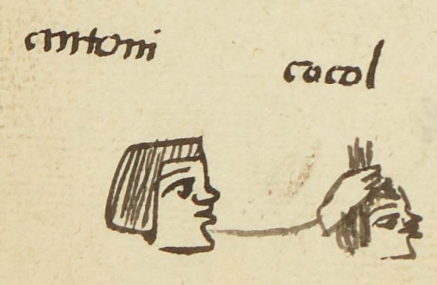Cocol (MH602r)
This black-line drawing of the simplex glyph for the personal name Cocol (perhaps "Quarrel," "Pain," or "Twisted") is attested here as a man’s name. The glyph shows a profile view of a human hand grasping the hair of another man, which could be part of a quarrel or dispute. Alternatively, the hand may be taking the man into custody, suggesting the other meaning of cocol. Finally, a third option is that this name Cocol is short for Cocoliloc, "Hated." See the dictionary entries.
Stephanie Wood
To pull or cut someone's hair in Nahua culture was a grave insult and cause of intense emotion. Sonya Lipsett-Rivera writes about the ritual humiliation of hair pulling in Religion in New Spain, eds. Susan Schroeder and Stafford Poole (2007), 79.
Stephanie Wood
antoni cocol
Antonio Cocol
Stephanie Wood
1560
anger, riña, enojo, ira, pelea, nombres de hombres

cocol(li), a quarrel, pain, something twisted, or the divine force of fire, https://nahuatl.wired-humanities.org/content/cocolli
cocol, to be entrusted to another person, https://nahuatl.wired-humanities.org/content/cocol
cocolia, to detest or hate someone, https://nahuatl.wired-humanities.org/content/cocolia
posiblemente, Pelea, Dolor, Retorcido, Riña, o Enojo
Stephanie Wood
Matrícula de Huexotzinco, folio 602r, World Digital Library, https://www.loc.gov/resource/gdcwdl.wdl_15282/?sp=283&st=image.
This manuscript is hosted by the Library of Congress and the World Digital Library; used here with the Creative Commons, “Attribution-NonCommercial-ShareAlike 3.0 License” (CC-BY-NC-SAq 3.0).













